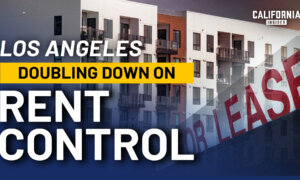Commentary
Anybody who has ever observed and studied the homeless situation in California will readily see how nonprofit service providers enabled by our political leaders not only have helped create the crisis, but have institutionalized homelessness as a way of life.
Now, a new conduit for corruption in the state of California is rearing its ugly head, and a word to the wise is to recognize this demon for what it really is. In brief, it is the role that nonprofits are playing in the state housing mandate that the governor’s office and our Legislature are promoting.
I am not talking here about the role of traditional nonprofits in our state’s economy, such as those that provide services and benefits in the private sector in a variety of charitable and educational endeavors. For the most part, those are self-funded and operate within the confines and purposes dictated by IRS codes.
No, I am talking about those nonprofit organizations that have been specifically set up and certified by elected politicians to receive awards and spend your hard-earned tax dollars and public funds to engage in the development, construction, ownership, master leasing, and/or management of housing that the state defines as necessary, whether needed or not.
Bear with me while I describe the scenario unfolding before our very eyes.
An Ambitious Power Grab
It is indeed one of the most Draconian and deceptive ploys that I have witnessed in my lifetime that legally allows the state to take over ownership of private property. If it goes unchecked and unchallenged, you, the voter, will have been fooled again, and all because of your good nature that would like to see roofs over the heads of those who might be disadvantaged or fiscally challenged. No one wants to see anybody suffer because of a lack of funds to adequately purchase shelter. But there is a right way and a wrong way to solve the problem.
If we are to believe the narrative being spun by our “ever so concerned” leaders, the private sector can no longer be counted on to deliver the number of housing units that the state tells us we must build within the next eight years. The number of units they say we need is highly speculative and biased toward a very low-income demographic. They subscribe to the “build it and they will come” theory. If they cannot get enough low-income tenants, they always have the homeless to fill the gaps.
Tilting the Playing Field
According to the state’s housing gurus, private for-profit developers are only concerned with building luxury units in the million-dollar range. This simply isn’t true. Any private for-profit developer will tell you it could build for much less per unit if it were not subject to the onerous red tape, regulations, and planning-approval delays that the nonprofits are not subject to. This systematic rigging of the playing field against the private-sector developers is exactly what has contributed to the affordable-housing deficit.
The for-profit housing developers are being shut out of the housing market because “profit,” “free enterprise,” and “private property” are considered bad words among the politically correct today. The real greed-mongers are the politicians who are capitalizing on these sentiments. They much prefer the power, control, and influence that the utilization of nonprofits provides.
Profit has always been a strong motivator for progress, especially because it can produce the most material gain for the masses when properly utilized. However, the lure of the power and control provided through specially created nonprofits is much stronger, especially in the public arena. Anyone who questions the basic tenets of profit, free enterprise, and private property in an economic system should study Economics 101 and comparative economics theories.
Because most of today’s “housing gurus” and our governor push the theory that one of the basic functions of government is to provide housing for all who need it, the state has issued a housing element that mandates the participation of all counties and municipalities. This mandate is no longer voluntary, and financial incentives are withheld from those counties and communities that do not go along with the program.
The governor and his misguided housing gurus have called for 2.5 million new units of housing to be built by 2030, of which about 50 percent shall be defined as “affordable.”
The definition of affordable has been continually evolving, but at the moment it means units that would not cost more than 30 percent of annual gross household income to rent, or units that are subsidized by local, state, or federal funds. The whole “affordable” concept will soon be abandoned in favor of whatever the state decides it will be.
On March 4, one of our state legislators proposed free loans to illegal immigrants to help them in their “affordability crisis.” Of course, all such loans would have to be administered via one of the chosen nonprofits!
The Housing Mandate
To accomplish this, all communities must comply with the state mandate and build new housing, whether needed or not, and regardless of infrastructure needs or what it might do to the character of a neighborhood, town, village, county, and so on.
To sweeten the pot, at least $30 billion in taxpayer money has been invested in housing-related funding since our present governor took office. In San Francisco alone, approximately $1.2 billion has been put forth as housing-related bonds since 2015. These funds, along with multiple new bond monies, eliminate the need for private developers and their private sources of funding, because all the costs of financing and building are covered by the state. The state is acting as “the bank” in its use of nonprofits to do the building.
Also, to add a little insurance that their chosen nonprofits will always be in the mix, communities such as San Francisco have passed laws that give nonprofits the right of first refusal and right of first acceptance of the sale of all properties with three units or more. With their one-size-fits-all approach, these planning amateurs are not the least bit concerned with what true housing needs may or may not exist, but only with how they can best control people in a fashion that furthers their political agenda, as you will soon see.
Approximately two decades ago, there was concern that there was a growing shortage of “affordable” housing available or being built by private developers to accommodate those of lower income levels. If one was spending more than a third of his or her income on housing, such housing was not considered acceptable or affordable. Thus, legislation was eventually passed that required private for-profit developers to set aside as “affordable” 20 percent of whatever number of units they built.
Perpetuating Political Control
Instead of incentivizing the private for-profit builders with a multitude of intelligent approaches that would produce more than enough low-income housing, the politicians and planners decided to go against competitive market forces and penalize those in the construction business by limiting their ability to compete.
In the years since, the “20 percent” formula has only served to restrict more development. But now that the state has realized how much money, power, and control is attainable through the use of nonprofits to supply the housing, there is a whole different demographic that we must cater to and a different litmus test for who must be served under the “affordable” category, which will even include some homeless people if necessary.
If you are foolish enough to buy into this scheme and want a little bit of the action, don’t worry about qualifying, because if you wait long enough, eventually everybody will be able to afford a house. This is thanks to the state’s desire to use public funds to have select nonprofits build units that the state owns and controls, and to fund those who will occupy, but not own, the units! Mind you, this is a gigantic shift away from the principle, purpose, and concept of private property and home ownership, and how these relate to freedom in our American way of life.
The Money-Go-Round
Now, let’s throw into the discussion how and why these specialty nonprofits are so desirable to our elected leaders. Could it possibly be that it is because these nonprofits are so thankful to their benefactors that the nonprofits are more than willing to help out during election time with copious donations and street campaigners to ensure their own survival?
Knowing the political game as I do, I can unequivocally state that this is precisely one method that has been used very effectively by politicians to perpetuate themselves in office.
In closing, and FYI, check out on the internet just how many nonprofits operate within state business in California, and you will understand why we are controlled by one political party. So much for diversity, equality, and inclusion for all, except when it comes to control and power over taxpayer money!












